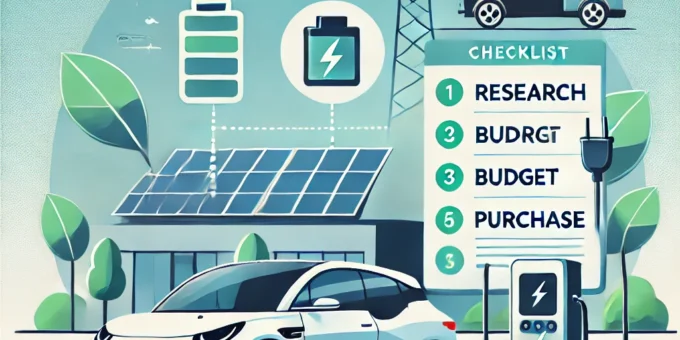
How to Transition to an Electric Car: A Step-by-Step Guide
Transitioning to an electric car (EV) is an exciting move toward sustainability, reduced emissions, and long-term savings. However, making the switch can feel overwhelming, especially if you’re used to traditional gas-powered vehicles. The good news? With the right information and preparation, the process is smoother than you think.
This step-by-step guide will walk you through everything you need to know about transitioning to an electric car, including choosing the right EV, setting up charging infrastructure, and maximizing your investment.
Why Make the Switch to Electric?
Switching to an electric car offers a host of benefits:
- Environmental Impact: EVs produce zero tailpipe emissions, reducing your carbon footprint.
- Lower Operating Costs: Charging an EV is cheaper than filling up a gas tank, and maintenance costs are significantly lower.
- Improved Performance: Electric motors deliver instant torque for smooth, powerful acceleration.
- Access to Incentives: Many governments offer tax credits, rebates, and incentives for EV buyers.
- Future-Proofing: As governments worldwide shift toward clean energy policies, owning an EV positions you ahead of the curve.
Step 1: Understand the Basics of EVs
Electric vehicles come in two primary types:
- Battery Electric Vehicles (BEVs): Fully electric, relying solely on a battery for power. Examples include the Tesla Model 3 and Nissan Leaf.
- Plug-in Hybrid Electric Vehicles (PHEVs): Combine an electric motor with a traditional gas engine. They offer an electric-only range for shorter trips and switch to gas for longer drives.
Understanding these options will help you decide which type best suits your needs.
Step 2: Assess Your Driving Needs
Before purchasing an EV, evaluate your typical driving habits:
- Daily Commute: How many miles do you drive daily? Most EVs offer ranges between 150–400 miles on a full charge.
- Charging Access: Do you have access to home or workplace charging?
- Road Trips: If you frequently take long trips, you may want a vehicle with a larger range or fast-charging capabilities.
Knowing your needs will help narrow your options and ensure you choose the right EV.
Step 3: Research Electric Car Models
The EV market offers a wide variety of options, from compact cars to SUVs. Here’s what to consider:
- Range: Choose a car with a range that comfortably exceeds your daily mileage.
- Price: EVs are available at various price points, and incentives can make them more affordable.
- Features: Look for features like regenerative braking, smart infotainment systems, and advanced safety options.
- Reputation: Check reviews, reliability ratings, and warranty coverage for the models you’re considering.
Step 4: Explore Incentives and Tax Credits
Many governments offer incentives to make EV ownership more affordable. For example:
- U.S. Federal Tax Credit: Up to $7,500 for qualifying vehicles.
- State and Local Incentives: Rebates, reduced registration fees, or free HOV lane access in certain states.
- Utility Company Discounts: Some utility providers offer rebates for installing home chargers or reduced electricity rates for EV charging.
Research available incentives in your area to maximize your savings.
Step 5: Set Up Home Charging Infrastructure
Home charging is the most convenient and cost-effective way to charge your EV. Here’s what to know:
- Level 1 Chargers: Use a standard 120-volt outlet. Slow but sufficient for overnight charging if you drive less than 40 miles daily.
- Level 2 Chargers: Require a 240-volt outlet. Faster and ideal for drivers with longer commutes or multiple EVs.
Hire a licensed electrician to install a Level 2 charger and ensure your home’s electrical system is up to the task.
Step 6: Learn About Public Charging Networks
When traveling, you’ll need to rely on public charging stations. Popular networks include:
- Tesla Superchargers: Exclusive to Tesla vehicles.
- Electrify America: Compatible with most EVs and offers fast-charging options.
- ChargePoint and EVgo: Widely available Level 2 and DC fast chargers.
Use apps like PlugShare or A Better Routeplanner to locate nearby chargers and plan your trips.
Step 7: Test Drive Electric Cars
A test drive can help you understand the unique driving experience of an EV. During your test drive, pay attention to:
- Acceleration and braking (instant torque and regenerative braking feel different).
- Comfort and cabin technology.
- Range and charging capabilities.
Step 8: Compare Ownership Costs
EVs often have higher upfront costs but lower long-term expenses. Savings come from:
- Fuel: Charging an EV costs less than buying gas.
- Maintenance: EVs require no oil changes, fewer moving parts, and minimal engine upkeep.
- Incentives: Tax credits and rebates can offset the initial purchase price.
Step 9: Address Range Anxiety
Range anxiety is the fear of running out of battery before reaching a charging station. Here’s how to overcome it:
- Plan your routes with charging stops in mind.
- Charge your battery before it drops below 20%.
- Familiarize yourself with local charging stations and their availability.
Step 10: Understand EV Maintenance
Maintaining an EV is simpler than a gas car, but it still requires attention:
- Battery Care: Avoid frequent fast charging to extend battery life.
- Tires: Check tire pressure regularly, as EVs are heavier and wear tires faster.
- Software Updates: Keep your EV’s software up to date for optimal performance.
FAQs About Transitioning to Electric Cars
Do I need a special license to drive an EV?
How long do EV batteries last?
Are there enough charging stations for long trips?
Can I charge my EV in the rain?
What’s the best time to buy an electric car?
Transitioning to an electric car is an exciting step toward a cleaner, more efficient future. By understanding your needs, researching your options, and preparing your home for charging, you can make the switch with confidence.
Take your time to explore the growing world of electric vehicles and enjoy the many benefits they offer, from environmental sustainability to long-term cost savings. The future is electric—start your journey today!